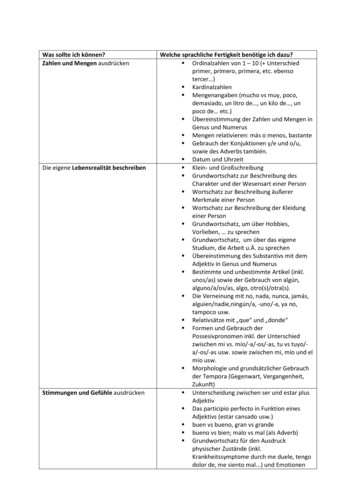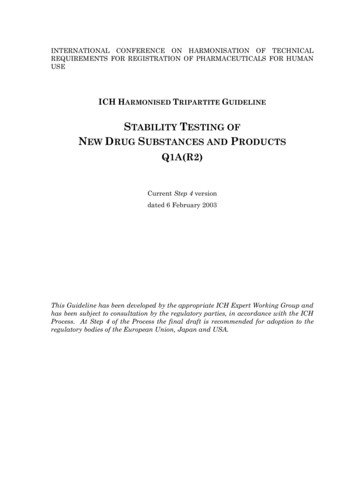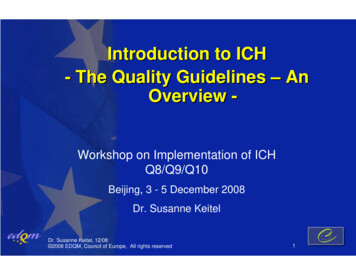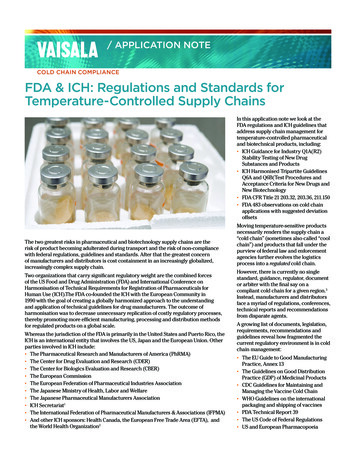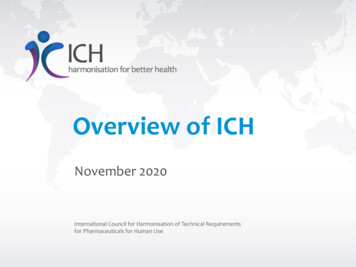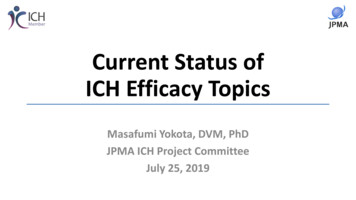
Transcription
INTERNATIONAL CONFERENCE ON HARMONISATION OF TECHNICALREQUIREMENTS FOR REGISTRATION OF PHARMACEUTICALS FOR HUMANUSEICH HARMONISED TRIPARTITE GUIDELINEEVALUATION FOR STABILITY DATAQ1ECurrent Step 4 versiondated 6 February 2003This Guideline has been developed by the appropriate ICH Expert Working Groupand has been subject to consultation by the regulatory parties, in accordance with theICH Process. At Step 4 of the Process the final draft is recommended for adoption tothe regulatory bodies of the European Union, Japan and USA.
Q1EDocument HistoryFirstCodificationQ1EHistoryDateApproval by the Steering Committee under Step 2 andrelease for public consultation.NewCodificationNovember20056 February2002Q1E6 February2003Q1ECurrent Step 4 versionQ1EApproval by the Steering Committee under Step 4 andrecommendation for adoption to the three ICH regulatorybodies.ii
EVALUATION FOR STABILITY DATAICH Harmonised Tripartite GuidelineHaving reached Step 4 of the ICH Process at the ICH Steering Committee meetingon 6 February 2003, this guideline is recommended foradoption to the three regulatory parties to ICHTABLE OF CONTENTS1.INTRODUCTION. 11.1Objectives of the Guideline .11.2Background.11.3Scope of the Guideline.12.3.GUIDELINES . 12.1General Principles.12.2Data presentation .32.3Extrapolation.32.4Data Evaluation for Retest Period or Shelf Life Estimation for DrugSubstances or Products Intended for Room Temperature Storage .32.4.1No significant change at accelerated condition .32.4.2Significant change at accelerated condition .52.5Data Evaluation for Retest Period or Shelf Life Estimation for DrugSubstances or Products Intended for Storage Below Room Temperature .52.5.1Drug substances or products intended for storage in a refrigerator .52.5.2Drug substances or products intended for storage in a freezer .62.5.3Drug substances or products intended for storage below -20 C .72.6General Statistical Approaches.7APPENDICES . 8Appendix A:Decision Tree for Data Evaluation for Retest Period or Shelf LifeEstimation for Drug Substances or Products (excluding Frozen Products) .8Appendix B: Examples of Statistical Approaches to Stability Data Analysis .8i
EVALUATION OF STABILITY DATA1.INTRODUCTION1.1Objectives of the GuidelineThis guideline is intended to provide recommendations on how to use stability datagenerated in accordance with the principles detailed in the ICH guideline “Q1A(R)Stability Testing of New Drug Substances and Products” (hereafter referred to as theparent guideline) to propose a retest period or shelf life in a registration application.This guideline describes when and how extrapolation can be considered whenproposing a retest period for a drug substance or a shelf life for a drug product thatextends beyond the period covered by “available data from the stability study underthe long-term storage condition” (hereafter referred to as long-term data).1.2BackgroundThe guidance on the evaluation and statistical analysis of stability data provided inthe parent guideline is brief in nature and limited in scope. The parent guidelinestates that regression analysis is an appropriate approach to analyzing quantitativestability data for retest period or shelf life estimation and recommends that astatistical test for batch poolability be performed using a level of significance of 0.25.However, the parent guideline includes few details and does not cover situationswhere multiple factors are involved in a full- or reduced-design study.This guideline is an expansion of the guidance presented in the Evaluation sections ofthe parent guideline.1.3Scope of the GuidelineThis guideline addresses the evaluation of stability data that should be submitted inregistration applications for new molecular entities and associated drug products. Theguideline provides recommendations on establishing retest periods and shelf lives fordrug substances and drug products intended for storage at or below “roomtemperature”*. It covers stability studies using single- or multi-factor designs and fullor reduced designs.*Note: The term “room temperature” refers to the general customary environmentand should not be inferred to be the storage statement for labeling.ICH Q6A and Q6B should be consulted for recommendations on the setting andjustification of acceptance criteria, and ICH Q1D should be referenced forrecommendations on the use of full- versus reduced-design studies.2.GUIDELINES2.1General PrinciplesThe design and execution of formal stability studies should follow the principlesoutlined in the parent guideline. The purpose of a stability study is to establish, basedon testing a minimum of three batches of the drug substance or product, a retestperiod or shelf life and label storage instructions applicable to all future batchesmanufactured and packaged under similar circumstances. The degree of variability ofindividual batches affects the confidence that a future production batch will remainwithin acceptance criteria throughout its retest period or shelf life.1
Evaluation of Stability DataAlthough normal manufacturing and analytical variations are to be expected, it isimportant that the drug product be formulated with the intent to provide 100 percentof the labeled amount of the drug substance at the time of batch release. If the assayvalues of the batches used to support the registration application are higher than 100percent of label claim at the time of batch release, after taking into accountmanufacturing and analytical variations, the shelf life proposed in the application canbe overestimated. On the other hand, if the assay value of a batch is lower than 100percent of label claim at the time of batch release, it might fall below the loweracceptance criterion before the end of the proposed shelf life.A systematic approach should be adopted in the presentation and evaluation of thestability information. The stability information should include, as appropriate, resultsfrom the physical, chemical, biological, and microbiological tests, including thoserelated to particular attributes of the dosage form (for example, dissolution rate forsolid oral dosage forms). The adequacy of the mass balance should be assessed.Factors that can cause an apparent lack of mass balance should be considered,including, for example, the mechanisms of degradation and the stability-indicatingcapability and inherent variability of the analytical procedures.The basic concepts of stability data evaluation are the same for single- versus multifactor studies and for full- versus reduced-design studies. Data from formal stabilitystudies and, as appropriate, supporting data should be evaluated to determine thecritical quality attributes likely to influence the quality and performance of the drugsubstance or product. Each attribute should be assessed separately, and an overallassessment should be made of the findings for the purpose of proposing a retest periodor shelf life. The retest period or shelf life proposed should not exceed that predictedfor any single attribute.The decision tree in Appendix A outlines a stepwise approach to stability dataevaluation and when and how much extrapolation can be considered for a proposedretest period or shelf life. Appendix B provides (1) information on how to analyze longterm data for appropriate quantitative test attributes from a study with a multifactor, full or reduced design, (2) information on how to use regression analysis forretest period or shelf life estimation, and (3) examples of statistical procedures todetermine poolability of data from different batches or other factors. Additionalguidance can be found in the references listed; however, the examples and referencesdo not cover all applicable statistical approaches.In general, certain quantitative chemical attributes (e.g., assay, degradation products,preservative content) for a drug substance or product can be assumed to follow zeroorder kinetics during long-term storage1. Data for these attributes are thereforeamenable to the type of statistical analysis described in Appendix B, including linearregression and poolability testing. Although the kinetics of other quantitativeattributes (e.g., pH, dissolution) is generally not known, the same statistical analysiscan be applied, if appropriate. Qualitative attributes and microbiological attributesare not amenable to this kind of statistical analysis.The recommendations on statistical approaches in this guideline are not intended toimply that use of statistical evaluation is preferred when it can be justified to beunnecessary. However, statistical analysis can be useful in supporting theextrapolation of retest periods or shelf lives in certain situations and can be called forto verify the proposed retest periods or shelf lives in other cases.2
Evaluation of Stability Data2.2Data presentationData for all attributes should be presented in an appropriate format (e.g., tabular,graphical, narrative) and an evaluation of such data should be included in theapplication. The values of quantitative attributes at all time points should be reportedas measured (e.g., assay as percent of label claim). If a statistical analysis isperformed, the procedure used and the assumptions underlying the model should bestated and justified. A tabulated summary of the outcome of statistical analysisand/or graphical presentation of the long-term data should be included.2.3ExtrapolationExtrapolation is the practice of using a known data set to infer information aboutfuture data. Extrapolation to extend the retest period or shelf life beyond the periodcovered by long-term data can be proposed in the application, particularly if nosignificant change is observed at the accelerated condition. Whether extrapolation ofstability data is appropriate depends on the extent of knowledge about the changepattern, the goodness of fit of any mathematical model, and the existence of relevantsupporting data. Any extrapolation should be performed such that the extended retestperiod or shelf life will be valid for a future batch released with test results close tothe release acceptance criteria.An extrapolation of stability data assumes that the same change pattern will continueto apply beyond the period covered by long-term data. The correctness of the assumedchange pattern is critical when extrapolation is considered. When estimating aregression line or curve to fit the long-term data, the data themselves provide a checkon the correctness of the assumed change pattern, and statistical methods can beapplied to test the goodness of fit of the data to the assumed line or curve. No suchinternal check is possible beyond the period covered by long-term data. Thus, a retestperiod or shelf life granted on the basis of extrapolation should always be verified byadditional long-term stability data as soon as these data become available. Careshould be taken to include in the protocol for commitment batches a time point thatcorresponds to the end of the extrapolated retest period or shelf life.2.4Data Evaluation for Retest Period or Shelf Life Estimation for DrugSubstances or Products Intended for Room Temperature StorageA systematic evaluation of the data from formal stability studies should be performedas illustrated in this section. Stability data for each attribute should be assessedsequentially. For drug substances or products intended for storage at roomtemperature, the assessment should begin with any significant change at theaccelerated condition and, if appropriate, at the intermediate condition, and progressthrough the trends and variability of the long-term data. The circumstances aredelineated under which extrapolation of retest period or shelf life beyond the periodcovered by long-term data can be appropriate. A decision tree is provided in AppendixA as an aid.2.4.1 No significant change at accelerated conditionWhere no significant change occurs at the accelerated condition, the retest period orshelf life would depend on the nature of the long-term and accelerated data.3
Evaluation of Stability Data2.4.1.1 Long-term and accelerated data showing little or no change over timeand little or no variabilityWhere the long-term data and accelerated data for an attribute show little or nochange over time and little or no variability, it might be apparent that the drugsubstance or product will remain well within the acceptance criteria for that attributeduring the proposed retest period or shelf life. In these circumstances, a statisticalanalysis is normally considered unnecessary but justification for the omission shouldbe provided. Justification can include a discussion of the change pattern or lack ofchange, relevance of the accelerated data, mass balance, and/or other supporting dataas described in the parent guideline. Extrapolation of the retest period or shelf lifebeyond the period covered by long-term data can be proposed. The proposed retestperiod or shelf life can be up to twice, but should not be more than 12 months beyond,the period covered by long-term data.2.4.1.2 Long-term or accelerated data showing change over time and/orvariabilityIf the long-term or accelerated data for an attribute show change over time and/orvariability within a factor or among factors, statistical analysis of the long-term datacan be useful in establishing a retest period or shelf life. Where there are differencesin stability observed among batches or among other factors (e.g., strength, containersize and/or fill) or factor combinations (e.g., strength-by-container size and/or fill) thatpreclude the combining of data, the proposed retest period or shelf life should notexceed the shortest period supported by any batch, other factor, or factor combination.Alternatively, where the differences are readily attributed to a particular factor (e.g.,strength), different shelf lives can be assigned to different levels within the factor(e.g., different strengths). A discussion should be provided to address the cause for thedifferences and the overall significance of such differences on the product.Extrapolation beyond the period covered by long-term data can be proposed; however,the extent of extrapolation would depend on whether long-term data for the attributeare amenable to statistical analysis. Data not amenable to statistical analysisWhere long-term data are not amenable to statistical analysis, but relevantsupporting data are provided, the proposed retest period or shelf life can be up to oneand-a-half times, but should not be more than 6 months beyond, the period covered bylong-term data. Relevant supporting data include satisfactory long-term data fromdevelopment batches that are (1) made with a closely related formulation to, (2)manufactured on a smaller scale than, or (3) packaged in a container closure systemsimilar to, that of the primary stability batches. Data amenable to statistical analysisIf long-term data are amenable to statistical analysis but no analysis is performed,the extent of extrapolation should be the same as when data are not amenable tostatistical analysis. However, if a statistical analysis is performed, it can beappropriate to propose a retest period or shelf life of up to twice, but not more than 12months beyond, the period covered by long-term data, when the proposal is backed bythe result of the analysis and relevant supporting data.4
Evaluation of Stability Data2.4.2 Significant change at accelerated conditionWhere significant change* occurs at the accelerated condition, the retest period orshelf life would depend on the outcome of stability testing at the intermediatecondition, as well as at the long-term condition.*Note: The following physical changes can be expected to occur at the acceleratedcondition and would not be considered significant change that calls for intermediatetesting if there is no other significant change: softening of a suppository that is designed to melt at 37ºC, if the melting point isclearly demonstrated, failure to meet acceptance criteria for dissolution for 12 units of a gelatin capsuleor gel-coated tablet if the failure can be unequivocally attributed to cross-linking.However, if phase separation of a semi-solid dosage form occurs at the acceleratedcondition, testing at the intermediate condition should be performed. Potentialinteraction effects should also be considered in establishing that there is no othersignificant change.2.4.2.1 No significant change at intermediate conditionIf there is no significant change at the intermediate condition, extrapolation beyondthe period covered by long-term data can be proposed; however, the extent ofextrapolation would depend on whether long-term data for the attribute are amenableto statistical analysis. Data not amenable to statistical analysisWhen the long-term data for an attribute are not amenable to statistical analysis, theproposed retest period or shelf life can be up to 3 months beyond the period covered bylong-term data, if backed by relevant supporting data. Data amenable to statistical analysisWhen the long-term data for an attribute are amenable to statistical analysis but noanalysis is performed, the extent of extrapolation should be the same as when dataare not amenable to statistical analysis. However, if a statistical analysis isperformed, the proposed retest period or shelf life can be up to one-and-half times, butshould not be more than 6 months beyond, the period covered by long-term data,when backed by statistical analysis and relevant supporting data.2.4.2.2 Significant change at intermediate conditionWhere significant change occurs at the intermediate condition, the proposed retestperiod or shelf life should not exceed the period covered by long-term data. Inaddition, a retest period or shelf life shorter than the period covered by long-term datacould be called for.2.5Data Evaluation for Retest Period or Shelf Life Estimation for DrugSubstances or Products Intended for Storage Below RoomTemperature2.5.1 Drug substances or products intended for storage in a refrigeratorData from drug substances or products intended to be stored in a refrigerator shouldbe assessed according to the same principles as described in Section 2.4 for drug5
Evaluation of Stability Datasubstances or products intended for room temperature storage, except whereexplicitly noted in the section below. The decision tree in Appendix A can be used asan aid.2.5.1.1 No significant change at accelerated conditionWhere no significant change occurs at the accelerated condition, extrapolation ofretest period or shelf life beyond the period covered by long-term data can be proposedbased on the principles outlined in Section 2.4.1, except that the exte
justification of acceptance criteria, and ICH Q1D should be referenced for recommendations on the use of full- versus reduced-design studies. 2. GUIDELINES 2.1 General Principles The design and execution of formal stability studies should follow the principles outlined in the parent guideline. The purpose of a stability study is to establish, basedFile Size: 201KB
